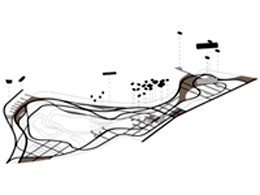STUDENTS PROJECTS
PROJECTS 2011
Students: George Lekkas, Christina Tsouma
Επιβλέπων καθηγητής : Γιάννης Πατρώνης / Professor : Yannis Patronis
Patras University School of Architecture
Diploma Project February 2011
At the end of the urban fabric in the city of Patras a nature habitat, the swamp, almost destroyed, is being revitalized and accommodates uses that intensify its importance as a nature element and an attraction as well. A center of ecological research, paths that cross the swamp, a museum of natural energy resources, the beach and the athletic facilities, propose an outlet for release from the human need for nature.

Our study site is placed in one of the most essential natural elements of the city of Patras, the Agyia swamp. Till today, it serves the residents as a sports amenity and the closest to the city organized beach. The intervention's area is about 414.000m2.
The substance of this project is about the configuration of the coastal area of the plot (1655m). The whole and combined spaces which exist today present a variety of characteristics, and a functional inconsistency through the swamp and the camping area. The uses that create the operational plan of the proposal are an energy museum and an ecological research center to maintain and honor the natural habitat. Secondary uses such as sports facilities, a small scale marina and beach facilities will also be available.

The basic idea for the masterplan composition rely on the geometric figures produced by the natural and artificial environment of the present situation. The circle abstractly encases the natural element of the swamp. The rectangle abstractly encases the formed space of the former camping. We connect the two figures with curves and basic alignments of the area using generally a matrix.
Through a research on the axis of circulation, orientation and wind, we choose the Kanellopoulou axis and the North-South which is the strongest wind in this place.

We create three entrances to the park that are connected through a circulation network, inside and circumferentially the site, which is used by cars only for replenishment and by mini buses for the visitors. By using the Kanellopoulou str. axis as one of the entrances there is a connection between the city and the park. The same connection is being achieved by the entrance of the seaside pedestrian road which extends and becomes a small scale's marina.



Inside the natural habitat (biotope) lakes are created by the removal of some reeds in order to revive the swamp. Inside the formed swamp the center of ecological research is placed above wooden platforms, watchtowers and routes that cross the swamp and unite its basic points.
The energy museum is placed in the territory of the old camping. Zones-exhibits of every type of energy conversion (wind, biomass, hydroelectric, geothermic, sun and wave) create an energy-park-museum. The central building and the zones that are developed around it are connected with a smaller circulation network of a smaller scale forming circumferentially and circular traffic distribution. In front of the central building an urban formed space is created by wooden elements with variety in topography of small scale. In the same space of interference we place a water tank that reminds of the water as a basic element of the project. Last item in this area is a green zone with hills of 6m. height which constitutes the city limit.
Around the swamp is developed a green park divided in regions by its own circulation network consisted of pedestrian and bicycle routes. In the same park a strip of formed planting is designed and crosses it. This strip depending on the region that it crosses has different planting and ground material based on the year seasons in order to produce relevant sceneries during each season.
The beach area is designed to accommodate the visitor's services through some wooden buildings as well as a square-deck. The marina area has some buildings for the visitors' services too as well as a small scale's square constructed using a basic material the concrete.












